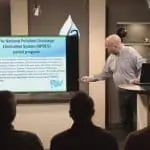

Christina Finizio, a recent graduate from the University of Florida now holds a Bachelor of Science in Environmental Engineering. Her journey with SCS began last summer when she joined the Boca Raton team as an Intern. Christina did not always know she would become an engineer, she thought she would study International Business just like her sister, but that quickly changed.
In high school, she attended a Hackathon event that took place in San Francisco, and that is when her interest in engineering began. In this event, she got a glimpse of computer science and other areas; her instincts kept drawing her to engineering. She looked at her options, and many did not seem appealing to her until she looked into environmental engineering. It ultimately made sense to go that route; she always had an interest in the environment and was the President of the Environmental Club in high school.
While in college, she participated in an exchange program and flew out to Madrid for the spring semester. Her experience was unforgettable. During this time, she made friends from all over Europe and the world, improved her Spanish and explored the world of tapas. While there, she took care of business and had an internship with Sacyr’s (Valoriza Servicios Medioambientales), a construction firm, where she joined their Environmental Engineering group. Her internship focused on environmental and solid waste. This was the first time she was exposed to the solid waste industry, and where her interest grew.
After completing her exchange and internship program, she arrived home with a clear idea and knowledge of what she wanted to do next. She did her research and found a well-known professor who teaches and researches in solid waste at her university. She took his classes and studied with his group so she could become more knowledgeable.
Christina is was involved on campus and joined many student organizations. At one of the Society of Women Engineers’ (SWE) event, she met SCS’s Director of Talent Acquisition, Jennifer McCafferty. Christina was interested in SCS’s work and kept in touch with Jennifer. The following summer she applied to SCS’s internship program and was offered an internship in the Boca Raton, Florida office. She enjoyed the experience because it focused on solid waste management her primary area of interest.
Shortly after graduating, Christina joined the SCS team as an Associate Professional at the Tampa, Florida office. She loves the culture, and enjoys working with her team; they are exceptionally friendly and are always willing to lend a hand. She feels her success is in part, due to her team’s focus on their clients’ needs and believes this focus and the team’s communication style is valuable to clients, her team and herself.
Every day her work is different; she can be out in the field one day and in the office the other. She works on a variety of reports such as annual air monitoring and greenhouse gas reports; performs construction oversite for gas systems and system expansions. Her internship and new responsibilities give her a deeper understanding of the solid waste business, and how landfill gas can become a renewable energy resource rather than an environmental impact.
One of her biggest challenges is being able to imagine or see what is going on in the landfill. Landfills are complex requiring environmental monitoring and multiple systems for continuous protection; no doubt that Christina will continue to learn from the best in the business and continue to excel as an Associate Profesional.
Her advice to new interns is to always ask for help when you need it and offer support to those around you. You will be surprised how much you will learn from different areas and how friendly and willing to mentor everyone is. She feels this mantra was what prepared her for her current position.
Fun facts you should know about Christina; that she loves to salsa dance, cook, and travel. She is the first one in her immediate family to hold a degree in engineering and the STEM field. Christina is a valuable member of the SCS Tampa office team and the firm.
SCS Engineers is fortunate to include Christina and our many other Young Professionals at SCS on our teams.

Depi holds a BA from UC Irvine and is active in the Society of Marketing Professional Services, Association of Proposal Management Professionals and the Business Development Association of Orange County. She is also a former member of the Professional Environmental Management Association.
Jed Douglas, a senior project advisor, brings more than 20 years of experience in project management, health and safety, air quality and more. He will direct and develop SCS’s industrial hygiene practice in the Southwest region leading business development and client service, managing projects, and managing staff. Jed is a certified industrial hygienist and safety professional, and an accredited U.S. Green Building Council LEED Professional.
In the community, Jed has served on the board of the Big Brothers and Big Sisters of the North Coast, the board of the Humboldt Area Saltwater Anglers, and as Editor of the Humboldt Bay Mycological Society newsletter.
Welcome to the SCS team – driven by client success!
If your facility is subject to Process Safety Management and Risk Management Plan regulations, or even if you are a mom and pop grocery store, during the life of your business you’ll experience organizational change. William Lape, of SCS Engineers, writes about how we need to consider the impacts on a facility’s PSM/RMP or ARM programs and on the operation of the ammonia refrigeration system itself.
Published in the RETA Breeze, Managing Organizational Change, How It Impacts Your Ammonia Refrigeration System
A well-sited transfer station could possibly save millions a year in operation costs, but it’s nearly impossible to find a location with every desirable checklist item. Project developers and one municipality share which priorities tend to matter the most and how to satisfy as many as possible, whether it is accessibility, traffic considerations, zoning, among others.
“There has been an uptick in construction of transfer stations in the past several years. Governments want to have facilities in their community for convenience,” says Michael Kalish, vice president of SCS Engineers.
Easy access is key.
“Haulers want to collect material quickly and easily to get rid of it and get back on the road. Otherwise, it costs a lot of money and time,” says Kalish.
Read the article How to Resourcefully Site a Transfer Station.
Stormwater management at landfills is changing as owners/operators are adapting their operating plans and designs to minimize the risks that come with heavier rainfall, and severe storm conditions. Landfill engineers are “overdesigning,” in regions hard hit in recent years by severe weather, and not designing for what is labeled as a statistically probable 25-year-storm.
Operations and maintenance are also preparing for changing conditions. William Mojica, Republic Services Director of Environmental Compliance is quoted in this article saying “It’s understanding the facility’s lifecycle, what best management practices (BMPs) are required and anticipating what may come.”
Jonathan Meronek, of SCS Engineers, notes similar strategies are being explored or employed along the U.S. coastlines including designing retention facilities to handle much larger storms.
With the number of LFG monitoring technologies out there, it can be difficult for operators to distinguish which is the best fit. The authors, Pat Sullivan and John Henkelman of Understanding Landfill Gas Monitoring Techniques, do just that, help readers find the approach that works best for their landfill monitoring needs.
Methane can be monitored above the surface of the landfill as a gauge of potential emissions or can be directly measured using techniques that test for the rate or flux of emissions. The above-surface monitoring techniques for gauging potential emissions include surface emission monitoring, ground-based or low-altitude imaging and satellite and aerial imaging.
Landfill methane measurement is the direct measurement of methane emissions from landfills. Direct measurement of methane is more expensive than surface emission monitoring. Four ways to measure landfill methane directly are flux chamber testing, plume measurement, micrometeorological methods, and dispersion modeling.
The purpose of the Quaternary Geology of Calumet and Manitowoc Counties, Wisconsin report is to provide an interpretation of the distribution and history of glacial deposits and a map showing their distribution.
This report should be useful for planning and development agencies in making land-use decisions, and to the non-metallic mining industry to aid in locating potential sources of aggregate.
The stratigraphic framework presented provides a basis for future detailed groundwater studies in the area. Finally, we hope that naturalists and others interested in the geologic history of the land on which we live will enjoy reading this report.
The report is available for sharing and downloading from the Wisconsin Geological & Natural History Survey.
We hope you find it both interesting and valuable. For geological surveys and information in other states, please contact us.
Stormwater Regulation is evolving, pushing more responsibility on to the dischargers by holding them accountable through categorization based on a discharger’s ability to meet numeric benchmarks. Additionally, how a discharger responds and applies effective BMPs determines their status. Ultimately, it is up to the industrial permittee to take the initiative, with an eye to priorities and feasibility for the future of their stormwater compliance program.
Stormwater managers and facility compliance personnel have only just begun to come to terms with the tiered ERA Response paradigm. However, as the tiered escalation becomes more common and ERA Level 1 and Level 2 reporting is performed, facilities are beginning to reach an equilibrium of stormwater compliance in terms of strategy, feasibility, budget and allocation of resources.

In his whitepaper, Jonathan Meronek, QISP, ToR, takes readers through the fundamental components of the ERA, Exceedance Response Action, or tiered Corrective Action compliance mechanism already in place, and currently being implemented in the States of California, Washington and the most recent General Permit in Oregon. ERA has wide-reaching implications for future NPDES permittees of industrial stormwater discharges. The escalation or “tiered” response standards is based on EPA Benchmark Levels and potential for future Numeric Effluent Limits (NELs). The three western states are viewed as “precursors” of what may be expected throughout the United States, as several key components of the forthcoming Multi-Sector General Permit (MSGP) will push other states to move towards similar ERA response scenarios and regulations.
SCS Engineers promotes Carlo Lebron to lead the Southeastern region operations, including all environmental consulting, landfill, landfill gas, and solid waste business. He commences his responsibilities immediately, under the title Business Unit Director, and is managing the staff and business operations of six offices in Florida and Georgia, and including projects in Puerto Rico. His primary office is located in Tampa, Florida.
Today’s landfill design professionals can help eliminate unsafe configurations and institute features that can proactively warn of and minimize hazards for operator and customer safety. Designers consider subgrade conditions, geotechnical factors and regulatory requirements when specifying how steep a landfill may be constructed.
The practical aspects of landfill operations and maintenance play a significant role in slope configurations since the landfill must provide safe access to monitoring points, environmental control features, and mowing.
Bob Gardner highlights the most important features to consider for landfill cells, including the design and construction phases of the entire landfill’s infrastructure. Bob covers a broad range of topics including:
Many states regulate the maximum design slope, and although these vary, it is up to the landfill designer to take practical, safety and regulatory considerations into account when establishing the slope configuration. Bob recommends working closely with the field staff to incorporate a design that is user-friendly, effective and safe.
Read the WasteToday article “Ensuring safety during landfill design,” by clicking here.
About the Author: Bob Gardner, PE, BCEE